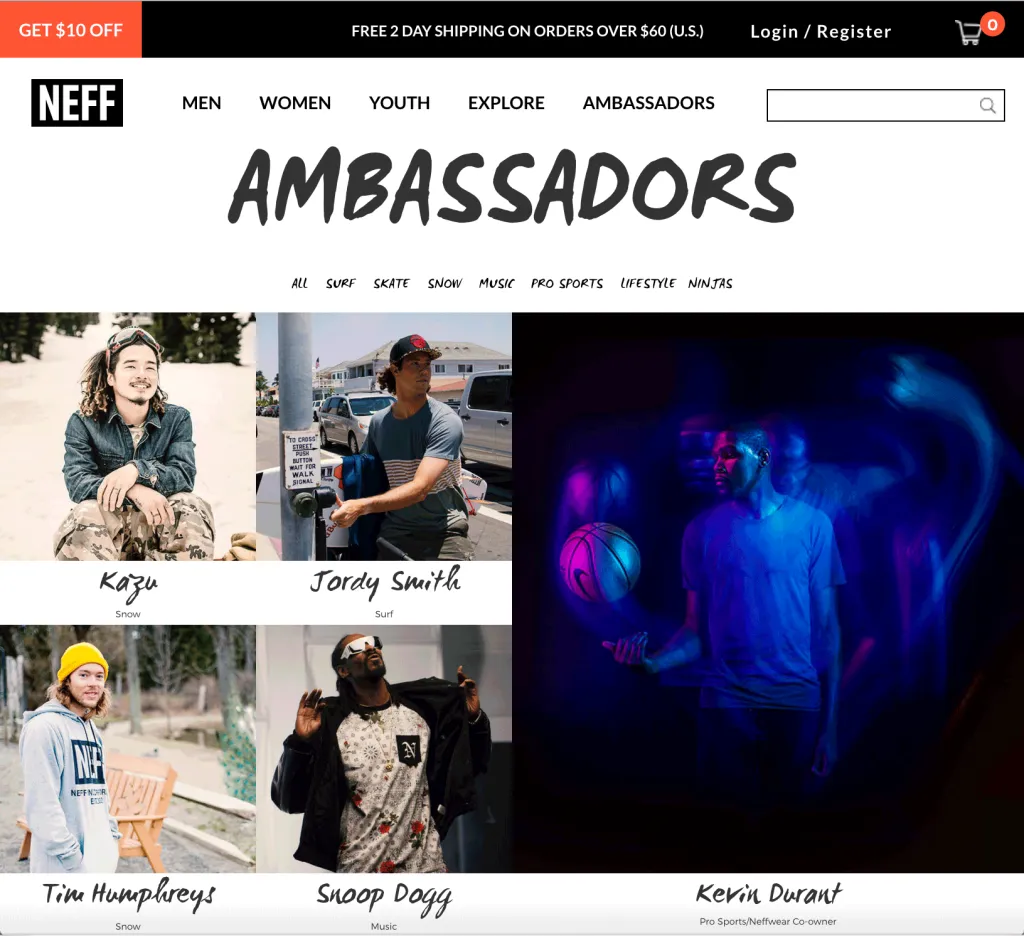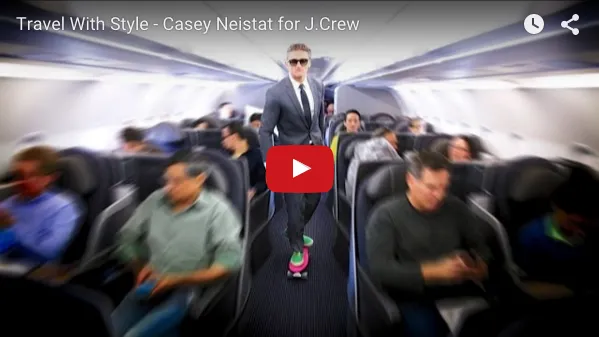How to Scale Your Influencer Marketing Strategy
Today consumers are researching on their own and heavily reliant on friends to inform their buying decisions.
Companies looking to position their products or services with an influencer marketing strategy are playing it smart and talking to their audiences in a way they want to hear.
That is, through the voice of one of their favorite people.
We’re about to go over how to design an engaging and successful influencer marketing campaign. Answering questions like - How do you find the influencers you need? What type of campaigns should you run? Core campaign techniques, such as user generated content, branded collection, and video will be covered - as will the metric you’ll want to consider. We’ll even look at leading e-commerce companies for examples of best practices in influencer marketing.
What is an Influencer?
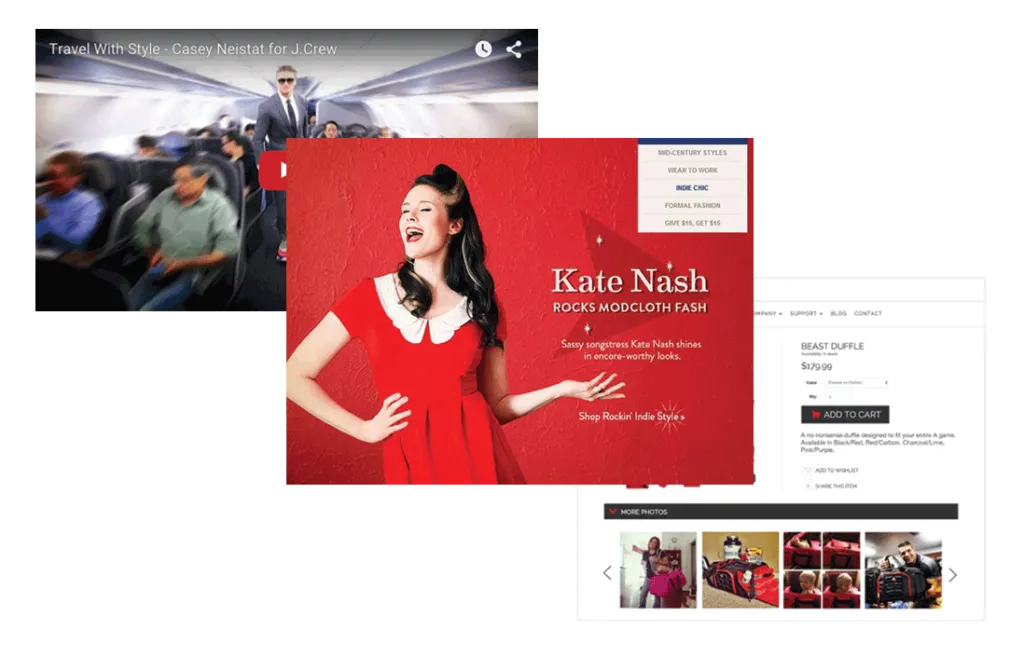 You can think about an influencer as a mutual friend connecting your brand with your target customers. When aligning with an influencer - from a blogger, to a celebrity, or industry-leader - you’re aligning yourself with their audience. Given the loyalty of their audience, an influencer can drive traffic to your site, boost your social media exposure, and directly sell your product or service.
You can think about an influencer as a mutual friend connecting your brand with your target customers. When aligning with an influencer - from a blogger, to a celebrity, or industry-leader - you’re aligning yourself with their audience. Given the loyalty of their audience, an influencer can drive traffic to your site, boost your social media exposure, and directly sell your product or service.
The friend-of-a-friend model works well for marketing. Online personalities and celebrities have become mainstays of modern life and their advice is highly prized. Someone within a consumer’s circle of trust will inform the decision-making process.
Indeed, Nielsen tells us that 90 percent of consumers deeply trust recommendations of their peers. And only 33 percent trust ads.
With 74 percent of consumers reliant upon social media to inform purchasing decision, word-of-mouth (WOM) marketing is generating twice the sales of paid advertising.
The key is to make this seem as natural as possible. That comes down your goals, your content, and how you use them.
#1 Align Your Goals
As always, beginning with the end in mind will save you time, headaches, and resources. Asking yourself what exactly you’d like to achieve through your influencer campaign will help you get the most out of your influencer relationship, develop consistent content, and enable you up to measure your results.
Your goals might include:
- Raising awareness for a new program (measured in impressions)
- Driving traffic to a website (measured in clicks
- Increasing a fan base (measured in follows)
- Increasing engagement levels (measured by comments)
- Boosting the quality of content (measured by shares)
- Developing new brand ambassadors
- Promoting a new product/offering
- Boosting SEO through earned media
- Introducing you on new social platform
It’s key to remember that influencer marketing hinges upon a clearly defined business relationship between your company and the influencer. Influencers are looking to generate revenue while showcasing content that reflects their own values and passions. Companies are out to generate authentic, engaging content which will serve their specific purposes. This is a symbiotic relationship built around brand awareness, preference, and consideration.
#2 Define Your Ideal Influencer
When finding an influencer, two factors are most important: engagement and reach.
Ultimately, companies need someone who can seamlessly share content and drive sales action without distracting readers. This means that a good contextual fit is necessary. While it would sure be great to get access to Katy Perry’s audience - would Katy’s Perry’s endorsement of a SaaS platforms help drive sales? What contextual fit does a pop star have with software? This is an example of an influencer with a lot of reach but not a lot of engagement.
Some brands will wind up with brand advocates instead of influencers, so they're limited in terms of reach and sales drive. A VP of Sales might make a great brand advocate - but is he or she really going to drive sales for you? Ultimately, the influencer has earned follower’s trust and so can deliver messages for other brands. Ones that audiences are eager to consume.
Influencers with popular content tend to accumulate large followings. But this doesn’t necessarily make them the best fit for your company. Individuals with a select, niche following often drive better engagement from their fanbase. This is because more specialized subject matter retains a more loyal following.
Focalized readerships are more attentive to their influencer, more invested in the content, and very receptive to messaging within it. Finding the leading authority from a complementary niche within your market is a fantastic solution.
3 Qualities to Look for in Influencers
1-High Quality Content: Look to people who consistently produce quality content that resonates with audiences, gets shares across social platforms, and prompts conversations.
2-Engagement with their Audience: An ideal influencer creates content that inspires interaction from readers. Someone that generates lots of questions, comments, re-post, shares, pins, retweets, and likes is a good fit.
Whenever there’s engagement, there’s earned media. Influencers excel at creating discussions, and discussions mean more trust for a topic or idea through familiarity. When a topic is talked about, shared, and reposted there’s more trust being spread around for your product.
“81 percent of US respondents indicated that their friends’ social media posts have directly influenced their purchase decisions.” --Forbes
3-Multi-Platform Presence: A multi-touch approach to your influencer marketing strategy will reap huge rewards. An influencer with an active voice across multiple social channels will maximize your efforts and ROI.
Influencer Campaign Example: Neff Headwear
Neff positions itself as a fun-forward lifestyle brand, flying under the phrase, “You’re one of us now.” If that’s true, then their audience is part of a collective of enlisted influencers such as Kevin Durant, Kate Upton, Snoop Dogg, Deadmau5, and Jaden Smith.
(Source)
This list of “ambassadors” speaks to the audience through Snapchat, Youtube, Instagram - any means to share the life-is-extremely-good-right-now message. Neff excels at staying atop the hype of current cool with their celebrity friends, bringing a pulse of fresh, exciting entertainment to its viewers. By honing in on who’s got the ear of the youth, Neff reaches the oft-coveted millennial market through the coolest kids around.
Tracking Metrics for Influencer Marketing
Of course, you’ll want to know what effect your campaign is having with your consumers. Depending upon the scope of your campaign and its goals, you’ll gauge success differently. As you can see below, the five stages customer’s move through with products come full circle within the influencer marketing campaign.
(Source)
This chart catalogues the buyer’s journey through a brand experience and the means for interaction. A well-made influencer campaign will optimize its strategy for multi-touch engagement across social platforms, landing pages, content giveaways, and website traffic.
70 percent of internet users would rather learn about a product through content rather than traditional advertising. As a result, analytics will be important for determining click through rates, time on page, and conversion rates through inbound platforms. Tracking methods aligning with KPIs will reveal how and where to make tweaks.
Influencer Campaign Example: User Generated Content
Influencer marketing boasts a 37 percent higher retention rate because it hinges around consumer loyalty. When customers become loyal fans, their feedback and cultivated input can be incredibly effective at driving action with prospects.
Fashion ecommerce sites are using both influencers and user-generated content to maximum effect.
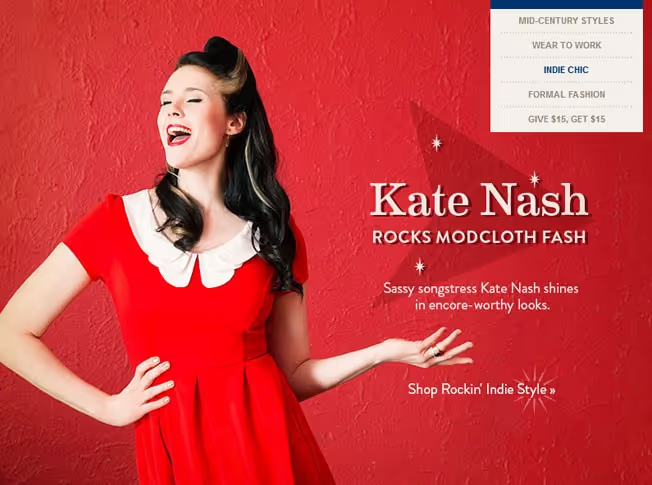
(Source)
The vintage clothing site, Modcloth, is doing a great job of this. Featuring famous singer Kate Nash as a cover model, the company is active in sharing images of their audiences enjoying Modcloth clothing.
Many companies are reaching out to fashion bloggers and sending them new garments for review. In return, the blogger writes about the clothing and posts photos to their eager audience.
Some brands send new products to influencers so the audience can enter a contest to receive the item. Sending a credit to an active social media figure, magazine writer, or blogger also makes it easy for the influencer to hit the site, pick out a piece of clothing, and review the overall experience.
After the influencer has helped generate user-generated content, it’s much easier to accumulate more of these organic, positive, micro-influencer referrals. Here are some ways to see more consumer generated content:
- Incentivize user-generated content (UGC) with product giveaways or discounts your service.
- Ask happy customers to answer case study questions, assuring them they’ll be able to approve the copy before it’s posted. Leveraging discounts or gift cards can smooth-over the initial hesitancy to share.
- If applicable, swap guest posts.
- Comment in discussion forums such as LinkedIn and Google Plus. By engaging your customers you’ll get access to some great quotes. You might even ask individuals to write a post based upon their comment - they’re sure to share this!
- If applicable, ask customers to upload photos and videos of themselves using your product. By promising to share their upload, you’re likely to see many willing shares.
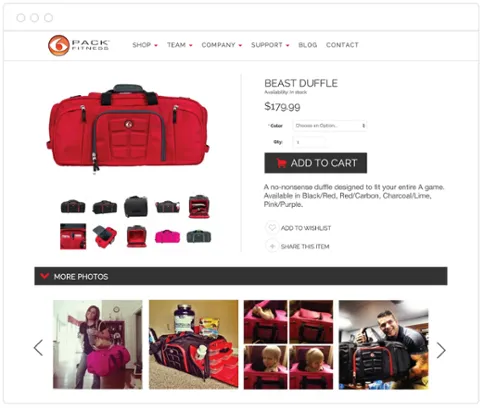
(Source)
Instagram style photos like these have been shown to be incredibly effective at improving conversion and click-through-rates. Digital agency Laundry Service ran a study (from over 100 million impressions) on these types of photo against the stock and studio style photos. The results?
- CTR rose from 2.35% to as high as 8%
- Conversion rates increased by 25% (ad performance to sales)
E-Commerce retailers have shown great success in using the principles of referral marketing and influencer marketing together. Nielsen tells us that 84% of people most trust referrals from people they know. By calling upon friends and associates to help make sales, companies can really augment the directive forces of the right influencer.
Influencer Campaign Example: Professional Video
Video is becoming one of the most widely circulated online mediums, from Snapchat, Periscope, Instagram, Facebook, to Youtube.
Video is 4x more engaging than text content and a one minute video is equivalent to 1.8 million words. 57 percent of consumers say that video makes them more confident of the quality of a purchase, so having influencers share branded videos can drive sales within this sizable group.
Creating case study videos with calls to action at the end can be effective because the audience trusts the influencer, whereas other times this would be picked of as “salesy.”
(Source)
JCrew’s ecommerce site has been successful with using influencer videos to drive traffic and increases sales. Irreverent Youtube celebrity, Casey Neistat, gives this J. Crew travel video wheels. The company seamlessly presents its offering in a bold new light while still keeping a grip on its classic aesthetic.
The most important features of a strong video are its hook and virality. No one wants to sit through another boring video. But a emotive video that can shock, wow, or intrigue the audience immediately can make a real impact.
#3 Find Your Influencer
Your ideal brand influencer won’t be hidden - you’ll just need to know where to look. Tuning into social media and blog posts about your brand will help you find influencers you may not have realized yet.
Social media monitoring will also help you find those influencers-to-be who may not yet be talking about your product or service but are very compatible.
Research Hashtags
Identify target influencers and then identify the hashtags they are using. Tuning into conversation around these hashtags will enable you to find active talkers but also the topics that will allow you to appeal to influencers.
Placing potential influencers in a Twitter list can help you organize and follow potential individuals easily. Hootsuite is a great option for this. Here’s what that looks like:
![]()
Google Alerts
Set alerts for keywords relevant to your brand to identify those who write about topics in your field. Creating alternatives for your brand name will allow you to find posts and articles containing your mentions and locate advocates that are already established.
![]()
#4 Invest in Storytelling
Influencer marketing revolves around content. Not only in terms of the content you create with/for the influencer, but also in that people gravitate to influencers because of the values they share and content they create themselves.
No matter which channels you use, this is very specific content delivered via a very likable, high-impact individual. It’s very much like native advertising, which does not interrupt the user experience but fits neatly within the message. Allow the influencer to tell a story, be themselves, and relate your product or service in a way that’s organic to them and their audience. Maybe the influencer creates their own content or maybe it’s a split responsibility.
4 Guidelines for Creating Effective Influencer Content
A few things to remember when building a good influencer relationship:
- Share program goals with the influencer and deliver them the tools needed to achieve them.
- Clearly define requirements while allowing room for influencer creativity and personalization.
- Create promotional content both for your brand and the influencers. Influencers will understand how to make the message relevant and sincere to their audience. This way viewers will absorb the messaging without filtering it as advertisement.
- Create brand messaging and CTAs that feel native to influencer’s original content.
Key Takeaways
Nowadays, consumers prefer to be lead by a familiar face - instead of being pushed or pulled towards a sale. Knowing the goals for your influencer marketing campaign will set you up to find the right influencer, the proper messaging, and gauge the quality of returns. With a streamlined influencer strategy, brands can acquire valuable user-generated content, use powerful branded videos, and maximum returns through social channels.
